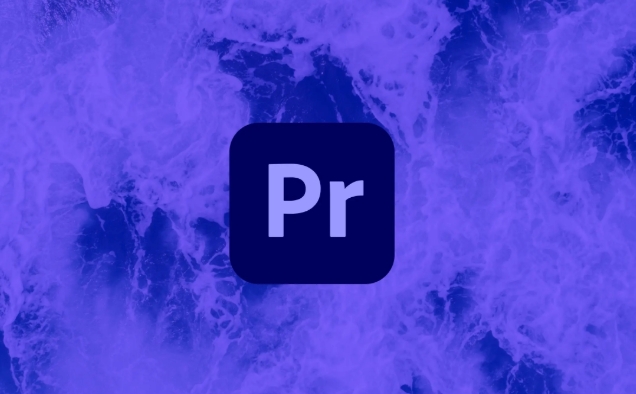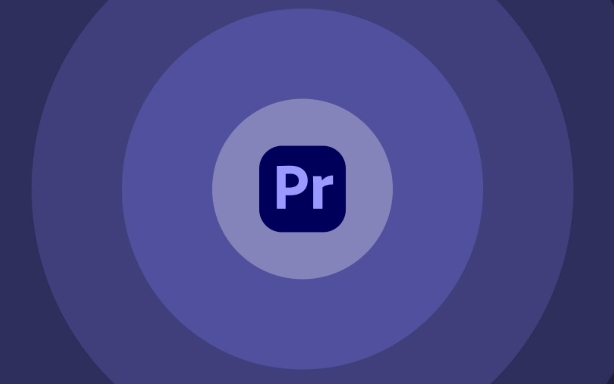how to stabilize shaky drone footage in Premiere Pro
The key to stabilizing the drone jitter screen in Premiere Pro lies in the correct use of the "deformation stabilizer VFX" and adjusting parameters. 1. Use "Deformation Stabilizer VFX", drag in the video to automatically analyze jitter, check "Crop Results" and appropriately improve "Smoothness". 2. Select the processing method according to the content of the screen. Use the fast moving lens with caution. You can manually set the stable area in complex scenarios. 3. Adjust key parameters such as motion mode, zoom and limit rotation and zoom to ensure the picture is natural. 4. After completion, check the playback fluency and export according to the original material parameters to ensure output quality.

Want to make the shaking drone look as stable as an old dog? Premiere Pro actually has ready-made and useful tools that can be done without exporting to other software. The key is to know when to use which function and how to adjust the parameters so as not to backfire.

1. Using "Deformation Stabilizer VFX" is the fastest way
This is a powerful tool that comes with Premiere, specializing in treating all kinds of jitters. The operation is very simple:

- Drag the material into the timeline
- Open the Effects panel and search for "Deformation Stabilizer VFX"
- Drag onto your video clip
It automatically analyzes the lens movement and tries to compensate for jitter. After the analysis is completed, preview it and see the effect. The default settings are sometimes enough, but if there are black edges or excessive stretching on the edge of the screen, you need to adjust manually.
Recommended settings:

- Find "Deformation Stabilizer VFX" in "Effect Control"
- Check "Crop Results" to automatically cut off black edges that appear after shaking.
- If the picture is too shaking, you can appropriately increase the "smoothness", but don't be too high, otherwise there will be a "floating feeling"
2. Understand the content of the screen before stability to avoid accidental injury
Not all jitters are suitable for processing in the same way. for example:
- Fast moving lenses (such as traveling through the woods): The deformation stabilizer may also "stabilize" the movement, which looks weird
- Slow flight and sway slightly (such as aerial photography): The stabilizer performs well at this time, almost one click to complete
If you encounter complex scenarios, you can consider manually setting the stable area in the "Track" section and tell Premiere which part is the subject you want to stabilize.
3. Don’t be afraid to adjust parameters, some details cannot be ignored.
Many people feel that the picture becomes blurry or slightly distorted after using the deforming stabilizer, which is usually because the default settings are not adjusted properly.
You can try a few key parameters:
- Motion mode : Selecting "Perspective" or "Subspace Distortion" can be more flexible to adapt to different jitter types
- Zoom : Turn on "Auto Scaling" to allow Premiere to automatically zoom in to fill in black edges
- "Rotation" and "Zoom" in Advanced Options : If you don't want the picture to look too exaggerated, you can appropriately limit these values
Remember to preview the parameters every time you change them, don’t rely on the naked eye to imagine the effect.
4. Remember to check the output quality after stability
Some people exported them directly after doing stable results, but found that the image quality dropped, the frame rate was incorrect or there were afterimages on the edge. We recommend that you do two things before exporting:
- Switch back to the "Sequence" tab to confirm that the playback is smooth and without lag
- When exporting, select the resolution and frame rate that are consistent with the original material to avoid image quality loss caused by secondary compression.
Basically that's it. The entire process is not difficult, but it is easy to ignore details, especially the problem of parameter settings and picture content matching. If used well, you can go from "handheld aerial photography" to "professional-level picture".
The above is the detailed content of how to stabilize shaky drone footage in Premiere Pro. For more information, please follow other related articles on the PHP Chinese website!

Hot AI Tools

Undress AI Tool
Undress images for free

Undresser.AI Undress
AI-powered app for creating realistic nude photos

AI Clothes Remover
Online AI tool for removing clothes from photos.

Clothoff.io
AI clothes remover

Video Face Swap
Swap faces in any video effortlessly with our completely free AI face swap tool!

Hot Article

Hot Tools

Notepad++7.3.1
Easy-to-use and free code editor

SublimeText3 Chinese version
Chinese version, very easy to use

Zend Studio 13.0.1
Powerful PHP integrated development environment

Dreamweaver CS6
Visual web development tools

SublimeText3 Mac version
God-level code editing software (SublimeText3)
 best Premiere Pro export settings for TikTok
Jul 30, 2025 am 01:37 AM
best Premiere Pro export settings for TikTok
Jul 30, 2025 am 01:37 AM
ToensureTikTokvideoslooksharpandplaysmoothly,useH.264codecwith25–50Mbpsbitrate,setresolutionto1080x1920at30or60fps,anduseAACaudioat192kbps.StartwithaverticalsequenceinPremiereProtoavoidscalingissues,choosetheMatchSource–HighBitratepresetinMediaEncode
 how to export an alpha channel from Premiere Pro
Jul 30, 2025 am 02:10 AM
how to export an alpha channel from Premiere Pro
Jul 30, 2025 am 02:10 AM
To export video or image sequences with transparent channels from PremierePro, you need to select Alpha formats such as QuickTime animation encoding, ProRes4444 or PNG sequences; correctly set and check the "PreserveTransparency" option in MediaEncoder; make sure the background in the timeline is transparent and uses compatibility effects; pay attention to the compatibility issues between the player and import tools, such as QuickTimePlayer supports but Windows MediaPlayer does not, and the Alpha channel needs to be manually enabled when importing AfterEffects.
 how to add text in Premiere Pro
Aug 01, 2025 am 06:57 AM
how to add text in Premiere Pro
Aug 01, 2025 am 06:57 AM
There are four ways to add text in PremierePro. First, use the "Text Tool" to directly add and adjust the style; second, create a new text layer through the "Graphics" panel for easy layer management; third, adjust text styles and animations, use built-in templates or manually keyframes; finally, enhance readability, which can be achieved by adding background boxes or strokes.
 how to add motion blur in Premiere Pro
Jul 29, 2025 am 12:11 AM
how to add motion blur in Premiere Pro
Jul 29, 2025 am 12:11 AM
Adding dynamic blur in PremierePro can be achieved in four steps: 1. Add DirectionalBlur or TransformBlur to video clips and adjust the direction and blur length to enhance dynamics; 2. Enable the MotionBlur button on the timeline for clips with zoom, displacement or rotation animation to generate a real blur effect based on motion; 3. Turn on the MotionBlur option when using WarpStabilizer for anti-shake to retain natural dynamics; 4. Pay attention to select whether to use blur according to the content, turn off proxy mode, and avoid lag caused by multiple layers of blur superposition. Mastering these methods can effectively improve the realistic and smoothness of the video.
 how to export an AAF from Premiere Pro for a sound mix
Aug 01, 2025 am 06:58 AM
how to export an AAF from Premiere Pro for a sound mix
Aug 01, 2025 am 06:58 AM
ToexportanAAFfromPremiereProforasoundmix,firstensureyourtimelineiscleanandorganizedbyremovingunnecessarytracks,labelingalltracksclearly(e.g.,“VO,”“SFX,”“Music”),syncingofflinemedia,andflatteningnestedsequencesunlessneeded.Next,usethecorrectexportsett
 how to use the remix tool in Premiere Pro
Jul 28, 2025 am 02:40 AM
how to use the remix tool in Premiere Pro
Jul 28, 2025 am 02:40 AM
TheRemixtoolinPremiereProadjustsmusicclipdurationwhilepreservingrhythm.Touseit,selectthetool(orpressB),clicktheclip,anddragitsedgetostretchorshrinkit.Premiereanalyzestheaudio,markingbeat-basededits.Bestresultscomefromloop-basedmusic,avoidingextremest
 how to collaborate on a Premiere Pro project
Jul 31, 2025 am 06:10 AM
how to collaborate on a Premiere Pro project
Jul 31, 2025 am 06:10 AM
TocollaborateeffectivelyinPremierePro,usesharedstorageandprojectlockingtomanageaccess,splitworkloadswithseparatesequencesorbins,maintainversioncontrolwithbackups,communicatechangesclearly,anduseproxymediaforsmootherworkflow.First,setupacentralservero
 Premiere Pro not responding
Jul 29, 2025 am 12:46 AM
Premiere Pro not responding
Jul 29, 2025 am 12:46 AM
PremierePro stuck and unresponsive solutions include checking hardware performance, optimizing project settings and caches, closing unnecessary background programs, and updating software versions and drivers. First, ensure that the computer configuration meets the standards, use a multi-core CPU, at least 16GB of memory, graphics cards and SSD hard disks that support GPU acceleration; second, clean the media cache and change the cache path to the high-speed partition, and enable hardware accelerated decoding; then, close the background programs and plug-ins that occupy resources; finally, update PremierePro, graphics card drivers and related plug-ins to the latest version.







